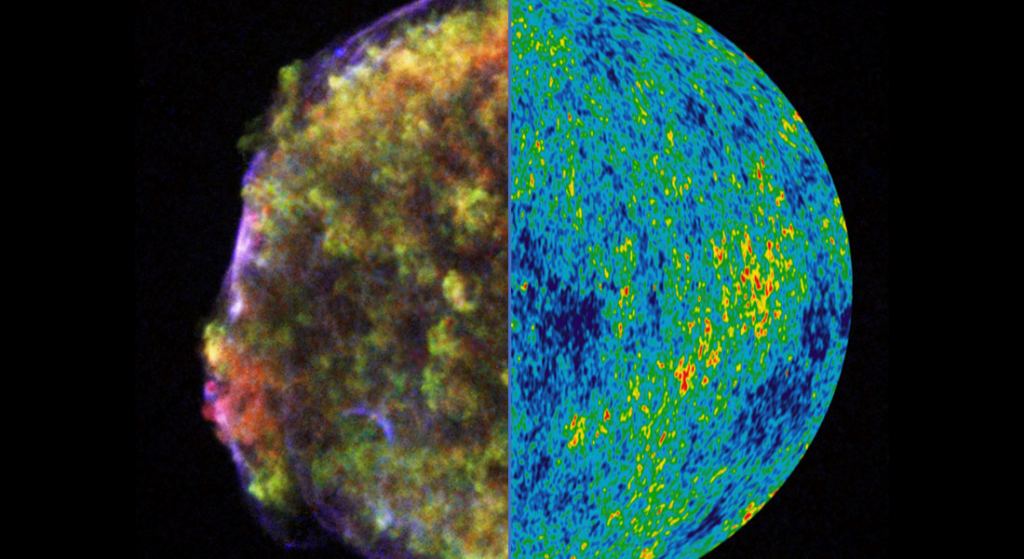According to some in the astrophysical community, there has been something of a " Crisis in Cosmology " in recent years. Though astronomers are all aware that the Universe is in a state of expansion, there has been some inconsistency when measuring the rate of it (aka. the Hubble Constant). This issue arises from the Cosmic Distance Ladder, where astronomers use different methods to measure relative distances over longer scales. This includes making local distance estimates using parallax measurements, nearby variable stars, and supernovae ("standard candles").
They also conduct redshift measurements of the Cosmic Microwave Background (CMB), the relic radiation left over from the Big Bang, to determine cosmological distances. The discrepancy between these two methods is known as the " Hubble Tension," and astronomers are eager to resolve it. In a recent study, an international team of astrophysicists from the Niels Bohr Institute suggested a novel method for measuring cosmic expansion. They argue that by observing colliding neutron stars (kilonovae), astronomers can relieve the tension and obtain consistent measurements of the Hubble Constant.
The research was led by astrophysicists from the Cosmic Dawn Center (DAWN) and the Niels Bohr Institute at the University of Copenhagen. They were joined by researchers from Tel Aviv University, the
Cahill Center for Astrophysics (California Institute of Technology), the GSI Helmholtz Centre for Heavy Ion Research, the Astrophysical Big Bang Laboratory, Helmholtz Research Academy Hessen for FAIR, and the DARK research group at the Niels Bohr Institute. The paper that describes their research recently appeared in the journal Astronomy & Astrophysics.
The expansion of the cosmos is something astronomers have known about for over a century, thanks to Edwin Hubble. By observing galaxies and measuring their light curves for redshift, he demonstrated that the more distant a galaxy was, the faster it receded from the Milky Way. This confirmed what many suspected about Einstein's Theory of General Relativity, which predicted that the cosmos was either in a state of expansion or retraction. By measuring the velocities at which other galaxies were moving away from our own, scientists have attempted to measure the Hubble Constant.
This expansion rate is measured in "speed per distance," and modern estimates place it at just over 20 km/s () per million light-years. That means a galaxy located 100 million light-years away recedes from us at 2,000 km/s (1,242 mps), while another galaxy 200 million light-years away recedes at 4,000 km/s (2,485 mps). However, using supernovae to measure distances and velocities of galaxies yields 22.7 ± 0.4 km/s, while analyzing the CMB yields 20.7 ± 0.2 km/s. That may not sound like much, but the difference also produces significantly different estimates for the age of the Universe -12.8 vs. 13.8 billion years, respectively.
While uncertainties were to be expected back in the early 20th century, improvements in measuring techniques have come a long way, and the discrepancy between measurements has diminished. As a result, astronomers and cosmologists are now at a point where they can state with confidence that the two values cannot both be correct. This has led many scientists to wonder if systematic biasing could be influencing one of the results or if special physics in the early Universe (a la early Dark Energy) might be involved.
In their paper, the team proposed a novel method for measuring distances, thereby helping to settle the ongoing dispute. The research was led by Albert Sneppen, a Ph.D. student in astrophysics at the Cosmic Dawn Center at the Niels Bohr Institute. As he explained in an NBI press release:
"When two ultra-compact neutron stars — which in themselves are the remnants of supernovae — orbit each other and ultimately merge, they go off in a new explosion; a so-called kilonova. We recently demonstrated how this explosion is remarkedly symmetric, and it turns out that this symmetry not only is beautiful, but also incredibly useful."
In a previous study (" Spherical symmetry in the kilonova AT2017gfo/GW170817 "), Sneppen and many of his colleagues in this latest study reported on the discovery of a "perfect explosion in space." This contradicted previous assumptions about kilonovae, indicating that the collision produced a perfectly spherical explosion. As they reported at the time, this discovery could provide insight into fundamental physics and a new means of measuring the age of the Universe. In another study released in September (" On the Blackbody Spectrum of Kilonovae "), Sneppen demonstrated that despite their complexity, kilonovae can be described by a single temperature.
This simple aspect of kilonovae, combined with their apparent symmetry, allowed Sneppen to deduce exactly how much light would be released by an event. Comparing this luminosity to how much light reaches Earth, astronomers can measure the distance to the kilonova, thereby leading to a novel and independent method for calculating the distance to galaxies containing kilonovae. As Darach Watson, an associate professor at the Cosmic Dawn Center and a co-author of the study, explained:
"Supernovae, which until now have been used to measure the distances of galaxies, don't always emit the same amount of light. Moreover, they first require us to calibrate the distance using another type of stars, the so-called Cepheids, which in turn also must be calibrated. With kilonovae we can circumvent these complications that introduce uncertainties in the measurements."
To demonstrate the new method's potential, the team applied it to a kilonova that was observed by astronomers in 2017. The resulting Hubble Constant calculation is closer to the value obtained through the CMB method, but whether this method can resolve the Hubble Tension remains to be seen. "We only have this one case study so far, and need many more examples before we can establish a robust result," said Sneppen. "But our method at least bypasses some known sources of uncertainty, and is a very clean system to study. It requires no calibration, no correction factor."
Further Reading: NBI
 Universe Today
Universe Today


